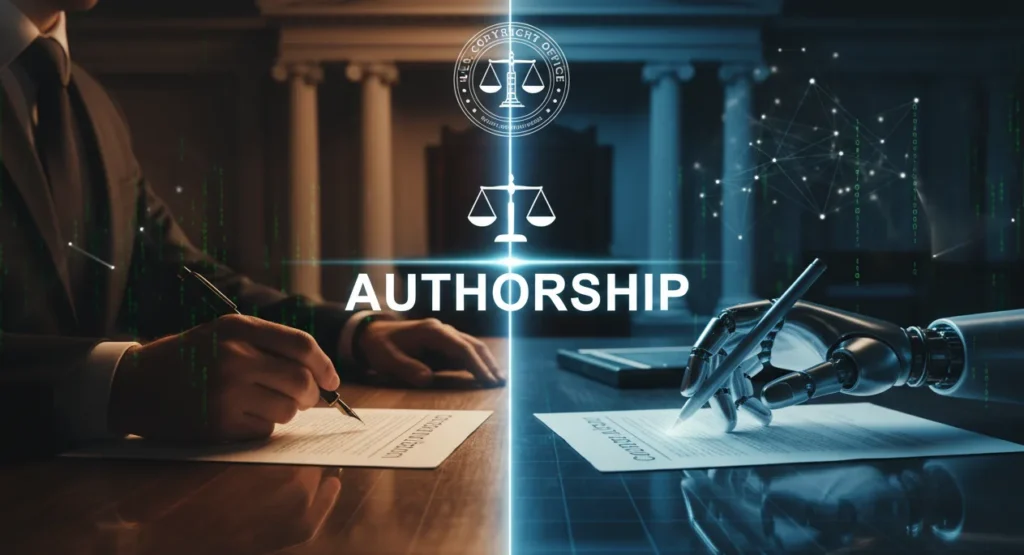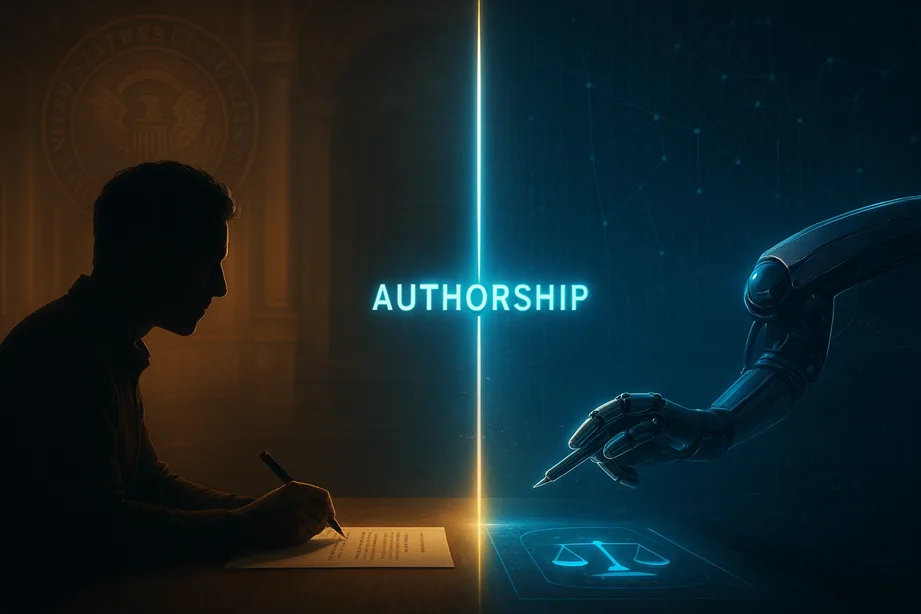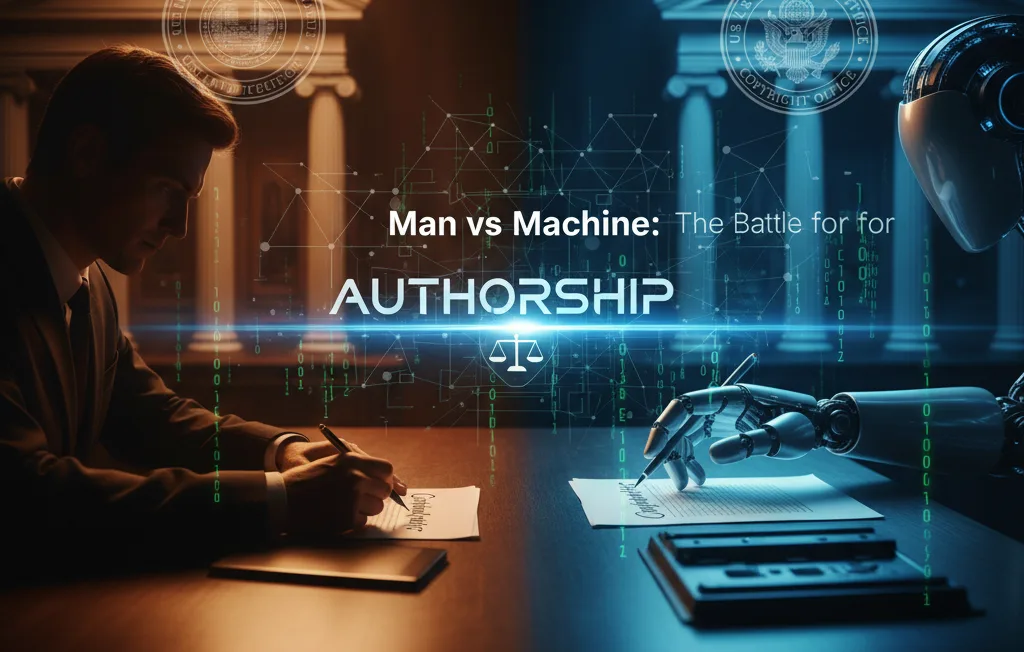The intersection of artificial intelligence and intellectual property law reached a defining moment with the Thaler vs Perlmutter case, a legal battle that fundamentally shaped how copyright law addresses AI-generated content. This groundbreaking decision by the U.S. Court of Appeals for the District of Columbia Circuit on March 18, 2025, settled a critical question that has profound implications for creators, technology companies, and the future of innovation: Can artificial intelligence be considered an author under copyright law?

The answer, delivered with unwavering clarity by the D.C. Circuit, was a resounding no. The court affirmed that the Copyright Act of 1976 requires all eligible works to be authored by human beings, marking a decisive victory for the human authorship doctrine and establishing clear boundaries for AI-generated content in the copyright landscape.
Read about The Jason Allen case
Table of Contents
The Visionary Behind the Controversy: Stephen Thaler and His Creativity Machine
Dr. Stephen Thaler, a pioneering computer scientist with decades of experience in artificial neural networks, stands at the center of this legal revolution. Since 1997, Thaler has been developing and publishing research on what he terms “Creativity Machines®” – sophisticated AI systems designed to autonomously generate creative content. His work represents one of the most ambitious attempts to blur the lines between human and machine creativity.
The Creativity Machine that sparked the Thaler vs Perlmutter litigation is a generative artificial intelligence system that operates through complex cycles of learning and unlearning without predetermined patterns. According to Thaler’s descriptions, the system autonomously created a two-dimensional artwork titled “A Recent Entrance to Paradise” – a work that would become the focal point of one of the most significant copyright cases of the digital era.
What makes Thaler’s approach particularly noteworthy is his transparency about the AI’s role in creation. Unlike many contemporary discussions about AI assistance in creative processes, Thaler explicitly acknowledged that his Creativity Machine operated without direct human intervention in the creative process, setting up the perfect test case for courts to address AI authorship directly.
The Legal Journey: From Copyright Office Rejection to Federal Appeals Court
The Thaler vs Perlmutter case began in 2019 when Dr. Thaler submitted a copyright registration application to the United States Copyright Office for “A Recent Entrance to Paradise.” In what would prove to be a strategically important decision, Thaler listed the Creativity Machine as the work’s sole author and himself merely as the copyright claimant.
The Copyright Office’s response was swift and unambiguous: denial based on the established human-authorship requirement. This wasn’t an arbitrary decision but reflected decades of consistent policy dating back to 1973, when the Copyright Office formally adopted regulations stating that works must “owe their origin to a human agent”.
Thaler’s persistence through the administrative process revealed the depth of his commitment to establishing AI authorship rights. He sought reconsideration from both the Copyright Office’s Registration Program and Review Board, each time reaffirming that his submission “lacks traditional human authorship—it was autonomously generated by an AI”. This consistency in position, while legally disadvantageous, demonstrated intellectual honesty that would later impact the court’s analysis.

The case then moved to federal court, where the U.S. District Court for the District of Columbia affirmed the Copyright Office’s denial. Judge Beryl Howell‘s ruling was categorical: “Human authorship is a bedrock requirement of copyright”. The district court also rejected Thaler’s work-made-for-hire argument and found that he had waived any claim to personal authorship by consistently representing that the work was created autonomously by AI.
The D.C. Circuit’s Definitive Ruling on Human Authorship in Thaler vs Perlmutter
The United States Court of Appeals for the District of Columbia Circuit’s decision in Thaler vs Perlmutter represents a masterclass in statutory interpretation and legal reasoning. Writing for the unanimous three-judge panel, Circuit Judge Patricia Millett methodically constructed an analysis that would become the definitive judicial statement on AI and copyright authorship.
The court’s approach was deliberately comprehensive, examining the Copyright Act through multiple analytical lenses. Rather than relying on a single interpretive method, the judges employed what they termed “traditional tools of statutory interpretation” to demonstrate that the word “author” refers exclusively to human beings within the context of federal copyright law.
Textual Analysis and Statutory Structure
The court’s textual analysis revealed the Copyright Act’s deep integration of human characteristics into its fundamental structure. The judges identified multiple provisions that make sense only when authors are understood to be human beings. These include requirements for authors to have legal capacity to hold property, the calculation of copyright duration based on human lifespans, inheritance provisions referring to “widows,” “widowers,” and “children,” and signature requirements for copyright transfers.
Perhaps most tellingly, the court noted that whenever the Copyright Act discusses machines, it consistently treats them as tools used by authors rather than as authors themselves. Computer programs are defined as “statements or instructions” designed to “bring about a certain result,” while machines are grouped with “devices” and “processes” as mechanisms that assist rather than replace human creativity.
Historical Foundation: CONTU and the Evolution of Copyright Policy
The Thaler vs Perlmutter decision draws significant strength from historical precedent, particularly the work of the National Commission on New Technological Uses of Copyrighted Works (CONTU). Established by Congress in 1974, CONTU was specifically tasked with studying how copyright law should accommodate “the creation of new works by the application or intervention of such automatic systems or machine reproduction”.
CONTU’s conclusions, reached after extensive deliberation by copyright experts from government, academia, and the private sector, were unambiguous: “there is no reasonable basis for considering that a computer in any way contributes authorship to a work produced through its use. The computer, like a camera or a typewriter, is an inert instrument, capable of functioning only when activated either directly or indirectly by a human”.

The D.C. Circuit emphasized that when Congress passed the Copyright Act of 1976, it did so with full knowledge of both the Copyright Office’s human authorship requirement and CONTU’s findings. The legislative choice not to define “author” while maintaining existing interpretations was seen as congressional adoption of the established understanding.
Deconstructing Thaler’s Legal Arguments
Dr. Thaler’s legal team, led by technology law scholar Ryan Abbott, presented several sophisticated arguments challenging the human authorship requirement. The Thaler vs Perlmutter case record reveals a multi-pronged strategy designed to establish AI authorship rights through constitutional, statutory, and policy arguments.
The Dictionary Definition Gambit
Thaler’s first argument relied on contemporary dictionary definitions, citing a 2023 Merriam-Webster definition of “author” as “one that originates or creates something.” This literalist approach suggested that the term’s plain meaning could encompass AI systems.
The D.C. Circuit decisively rejected this approach, emphasizing that statutory interpretation requires more than “finding a sympathetic dictionary definition.” The court stressed that judicial analysis must consider how Congress used terms within their statutory context, noting that substituting “machine” for “author” throughout the Copyright Act would create nonsensical references to machines having “children,” “widows,” “domiciles,” and “nationalities”.
The Work-Made-for-Hire Analogy
Perhaps Thaler’s most creative argument involved the work-made-for-hire doctrine, which allows corporations to be “considered the author” of works created by employees. Thaler argued that if non-human entities like corporations could achieve authorship status, so could AI systems.
The court’s response highlighted the critical distinction embedded in the statutory language. The work-made-for-hire provision uses the carefully chosen phrase “considered the author” rather than declaring employers to be authors outright. This language creates a legal fiction that transfers rights from human creators to hiring entities without eliminating the underlying requirement for initial human authorship.
The Constitutional Question Left Unresolved
One of the most intriguing aspects of Thaler vs Perlmutter is what the court chose not to address. The Copyright Office had argued that the Constitution’s Intellectual Property Clause itself requires human authorship, but the D.C. Circuit explicitly declined to reach this constitutional question.
This judicial restraint reflects the court’s adherence to the principle of deciding cases on the narrowest grounds possible. Since the statutory interpretation provided sufficient basis for affirming the Copyright Office’s decision, the constitutional question remains open for future litigation. This approach preserves flexibility for Congress to potentially modify copyright law while maintaining that any such changes would need explicit legislative action.
Implications for AI-Generated Content and Creative Industries
The Thaler vs Perlmutter decision’s impact extends far beyond academic legal theory, creating concrete consequences for how AI-generated content is treated in the marketplace. The ruling establishes that works created entirely by AI, without meaningful human creative input, enter the public domain immediately upon creation.
The Public Domain Effect
This public domain designation has revolutionary implications for business models built around AI-generated content. Companies cannot claim exclusive rights to purely AI-generated works, meaning competitors can freely copy, modify, and commercialize such content without copyright infringement liability. This creates interesting economic incentives favoring human-AI collaboration over purely automated generation.
The Human-AI Collaboration Framework
Importantly, the Thaler vs Perlmutter ruling does not prohibit copyright protection for works involving AI assistance. The court explicitly noted that “the human authorship requirement does not prohibit copyrighting work that was made by or with the assistance of artificial intelligence” as long as “the author of that work be a human being—the person who created, operated, or used artificial intelligence—and not the machine itself”.
This framework aligns with recent Copyright Office guidance distinguishing between different levels of human involvement in AI-assisted creation. Simple prompts to AI systems may not suffice for copyright protection, but substantial human creative input in selecting, arranging, or modifying AI outputs can support valid copyright claims.
The Future Legislative Landscape After Thaler vs Perlmutter
While the Thaler vs Perlmutter decision settled the immediate question of AI authorship under current law, it also highlighted the need for potential legislative action as AI technology continues advancing. The D.C. Circuit explicitly noted that policy arguments about AI innovation “would be a policy argument for Congress to address”.
Congressional Recommendations and Ongoing Studies
The Copyright Office has been actively studying AI-related copyright issues, releasing comprehensive reports that will inform future legislative discussions. The January 2025 report on copyrightability reaffirmed the human authorship requirement while acknowledging that this area of law continues evolving with technological advancement.
Congress has also begun addressing AI-related intellectual property issues through various proposed bills and reports. The House Bipartisan Task Force on Artificial Intelligence released a comprehensive report in December 2024 addressing AI and intellectual property concerns, suggesting that legislative attention to these issues is increasing.
Balancing Innovation and Traditional Copyright Values
The Thaler vs Perlmutter aftermath reveals ongoing tension between promoting AI innovation and maintaining copyright law’s traditional focus on incentivizing human creativity. Some commentators argue that denying copyright protection to AI-generated works could discourage investment in creative AI systems, while others contend that human creativity deserves special protection.
International Perspectives: How Other Countries Handle AI Authorship
The Thaler vs Perlmutter decision stands in interesting contrast to approaches taken by other jurisdictions grappling with similar questions. While the U.S. has firmly established human authorship requirements, other countries have adopted varying approaches to AI-generated content.
The UK’s Computer-Generated Works Provision
The United Kingdom’s Copyright, Designs and Patents Act includes specific provisions for “computer-generated works,” defining them as works “generated by computer in circumstances such that there is no human author.” The UK grants copyright in such works to “the person by whom the arrangements necessary for the creation of the work are undertaken”. This approach differs markedly from the U.S. position established in Thaler vs Perlmutter.
South Africa’s DABUS Patent Grant
Interestingly, Dr. Thaler achieved success in South Africa’s patent system, where DABUS became the first AI system to be granted a patent with AI listed as the inventor. This contrasts sharply with patent office rejections in the United States, Europe, and most other jurisdictions.
Japan’s Information Analysis Exception
Japan has taken a uniquely permissive approach to AI training data, with Article 30-4 of the Japanese Copyright Act allowing AI systems to use copyrighted works for training purposes without permission, provided the use is for “information analysis” rather than “enjoyment of ideas or emotions”.
The Broader DABUS Saga: Patents vs. Copyright
Dr. Thaler’s legal battles extend beyond copyright into patent law through his DABUS (Device for the Autonomous Bootstrapping of Unified Sentience) patent applications. While Thaler vs Perlmutter addressed copyright authorship, parallel litigation in Thaler v. Vidal challenged similar human authorship requirements in patent law.
The Federal Circuit’s decision in the patent case reached similar conclusions to the copyright ruling, affirming that patent inventorship requires natural persons. The Supreme Court declined to review the patent case, effectively endorsing the position that current intellectual property law requires human involvement for both inventorship and authorship.
This consistency across patent and copyright law suggests a broader judicial consensus about maintaining human-centered intellectual property systems, even as AI capabilities continue expanding.
Practical Guidance for Creators and Companies
The Thaler vs Perlmutter decision provides important practical guidance for anyone working with AI-generated content. The key distinction lies between using AI as a tool to assist human creativity versus relying on AI to generate content autonomously.
Best Practices for Copyright Protection
To ensure copyright protection for AI-assisted works, creators should:
- Maintain significant human input in the creative process
- Document human creative decisions and modifications
- Avoid claiming AI systems as authors in copyright applications
- Focus on human contributions when describing creative processes
- Consider how human creativity is expressed through AI assistance
Risk Management for Businesses
Companies building business models around AI-generated content should carefully consider the Thaler vs Perlmutter implications:
- Purely AI-generated content may not be protectable by copyright
- Competitors can freely use works that lack human authorship
- Investment in human-AI collaboration may provide better IP protection
- Clear documentation of human creative input becomes crucial
Frequently Asked Questions
Q: Does the Thaler vs Perlmutter decision mean AI cannot be used to create copyrightable works?
A: No. The decision specifically states that the human authorship requirement “does not prohibit copyrighting work that was made by or with the assistance of artificial intelligence” as long as a human serves as the author. AI can be used as a tool to assist human creativity.
Q: What happens to works that are created entirely by AI without human input?
A: Under the Thaler vs Perlmutter ruling, such works enter the public domain immediately and cannot be protected by copyright. Anyone can use, modify, or commercialize purely AI-generated works without permission.
Q: How much human input is required for copyright protection?
A: The courts and Copyright Office evaluate this on a case-by-case basis. Simple prompts may not suffice, but substantial human creative input in selecting, arranging, or modifying AI outputs can support copyright claims. The key is demonstrable human creativity that shapes the final work.
Q: Could Congress change the law to allow AI authorship?
A: Yes. The Thaler vs Perlmutter court explicitly noted that Congress has the authority to modify copyright law to accommodate AI authorship if it chooses to do so. However, any such changes would require explicit legislative action.
Q: How does this decision affect AI training on copyrighted materials?
A: The Thaler vs Perlmutter decision focused on AI authorship rather than AI training. The Copyright Office is addressing training issues in a separate report, and multiple lawsuits are currently challenging whether using copyrighted works to train AI systems constitutes fair use.
Q: What about AI-generated works in other countries?
A: Different countries have varying approaches. The UK provides some protection for computer-generated works, while Japan allows broader use of copyrighted materials for AI training. However, the U.S. position established in Thaler vs Perlmutter may influence international discussions.
Q: Does this decision affect patent law similarly?
A: Yes. Similar reasoning has been applied in patent cases involving AI inventorship. Dr. Thaler’s parallel patent litigation (Thaler v. Vidal) also failed, with courts maintaining that both copyright authorship and patent inventorship require human involvement.
Q: Can companies still build profitable businesses around AI-generated content?
A: Yes, but strategies may need adjustment. Companies can focus on human-AI collaboration, develop proprietary AI systems as trade secrets, or build value through services and platforms rather than relying solely on copyright protection for AI outputs.
The Thaler vs Perlmutter case represents a watershed moment in intellectual property law, establishing clear boundaries between human and machine creativity while preserving space for AI to serve as a powerful tool in human creative endeavors. As AI technology continues advancing, this decision provides a stable legal foundation that protects human creativity while encouraging innovation in AI-assisted creative processes.
The implications extend far beyond the courtroom, influencing business strategies, creative practices, and the fundamental relationship between humans and machines in the creative economy. While the door remains open for Congressional action to modify these rules, the current legal framework strongly emphasizes the irreplaceable value of human creativity in intellectual property law.
Relevant case: The Landmark Feng vs Dongshan Company Ruling: Chinese Court Denies AI-Generated Images Copyright Protection
Author
I am Adv. Arunendra Singh, a practicing advocate at the Allahabad High Court Lucknow Bench, Lucknow, presently as NLSIU Banglore and Founder of Kanoonpedia, where I create concise, legal guides and case analyses. Awarded the President of India’s Award for leadership and academic excellence, I also co-founded Clicknify to support legal-tech startups. Through my Legal Clarity™ framework, I help students and professionals navigate complex laws with clarity and engagement.